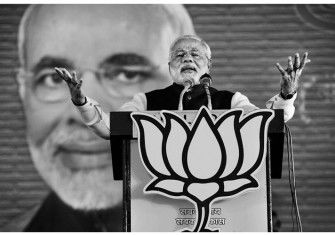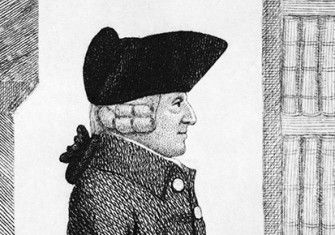Satan’s Bank Note
In the early 19th century ‘filthy rags’ – or banknotes – became a common form of currency. A surge in forgery followed, accompanied by a surge in harsh prosecutions. How did we get from gold to paper?
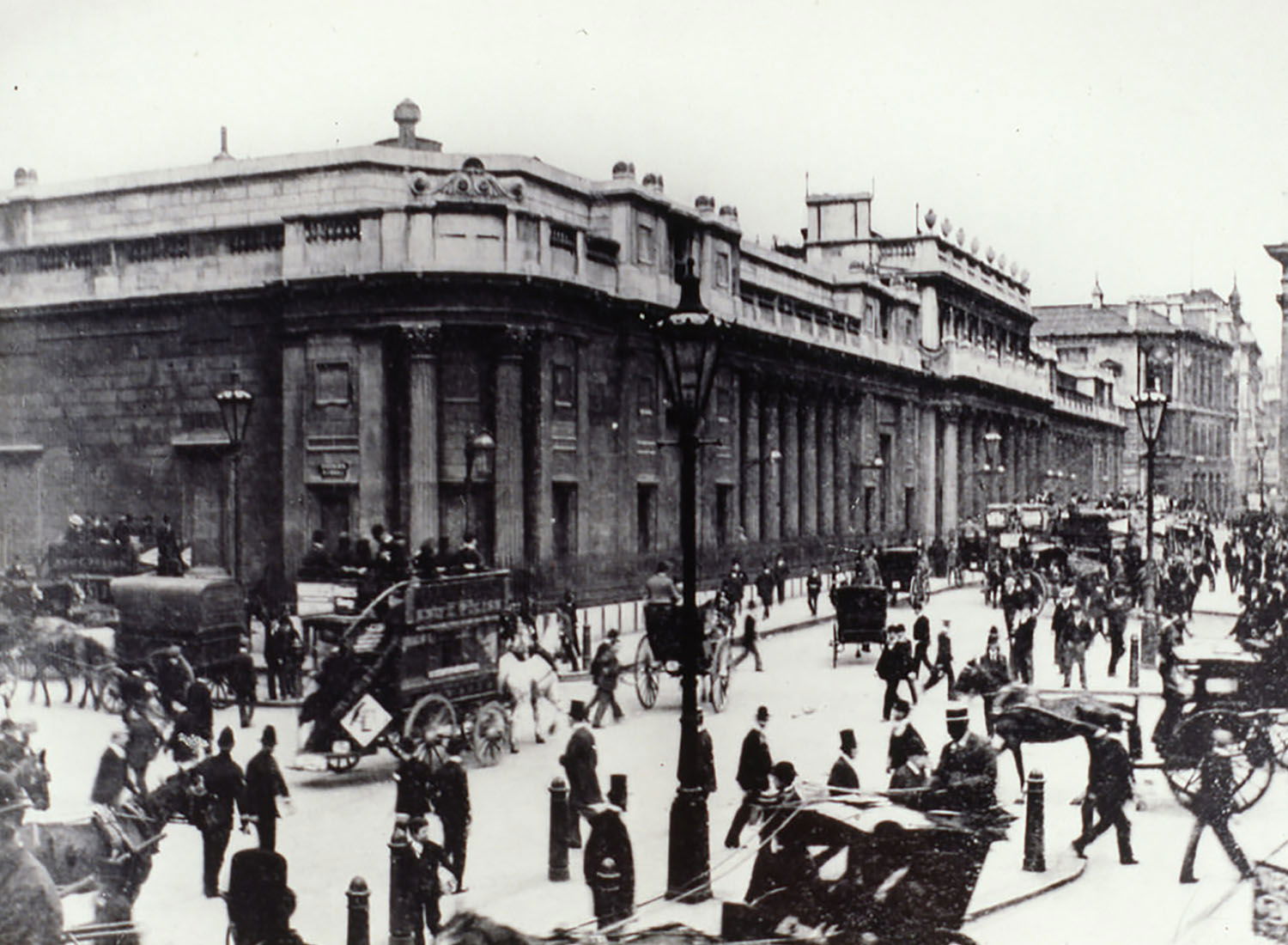
The Bank of England, 1897.
In 1820 a satirical pamphlet called ‘Satan’s Bank Note’ appeared on the streets of London. Accompanied by a woodcut engraving of five men being executed with the devil sitting on the gallows, the pamphlet offered a biting commentary on the epidemic of forgery trials that had broken out in Britain in the years following the end of the Napoleonic Wars. The anonymous author lays the blame entirely at the door of the Bank of England and its biggest debtor, the government of the day:
Near London’s ’Change there is a house,
(To name it I’m unwilling)
Where RAGS are sold, and for each Pound
John Bull gives twenty shillings.
The anonymity of the author, and their unwillingness to explicitly name the Bank of England, stemmed, no doubt, from fear of being prosecuted for libel or sedition. Ever since William Pitt’s government had effectively suspended the gold standard in 1797, ‘poor’ John Bull had been forced to accept paper in place of gold and silver. For the first time, but by no means the last, the nation was left wondering: what exactly is money?
The recent introduction of new banknotes and coins has seen the return of this question. Does it matter what it is made of? When did money just become a convenient medium of exchange as opposed to representing intrinsic value? Or, put another way, how did we get from gold to paper? Dismissed by some as Monopoly or plastic money, the new £5 and £10 notes in particular have come in for heavy criticism. The Bank of England claims that the choice of material, polymer, along with a number of other security features, makes the new notes harder than ever to counterfeit. Staying one step ahead of the forgers is, of course, the Bank of England’s objective.
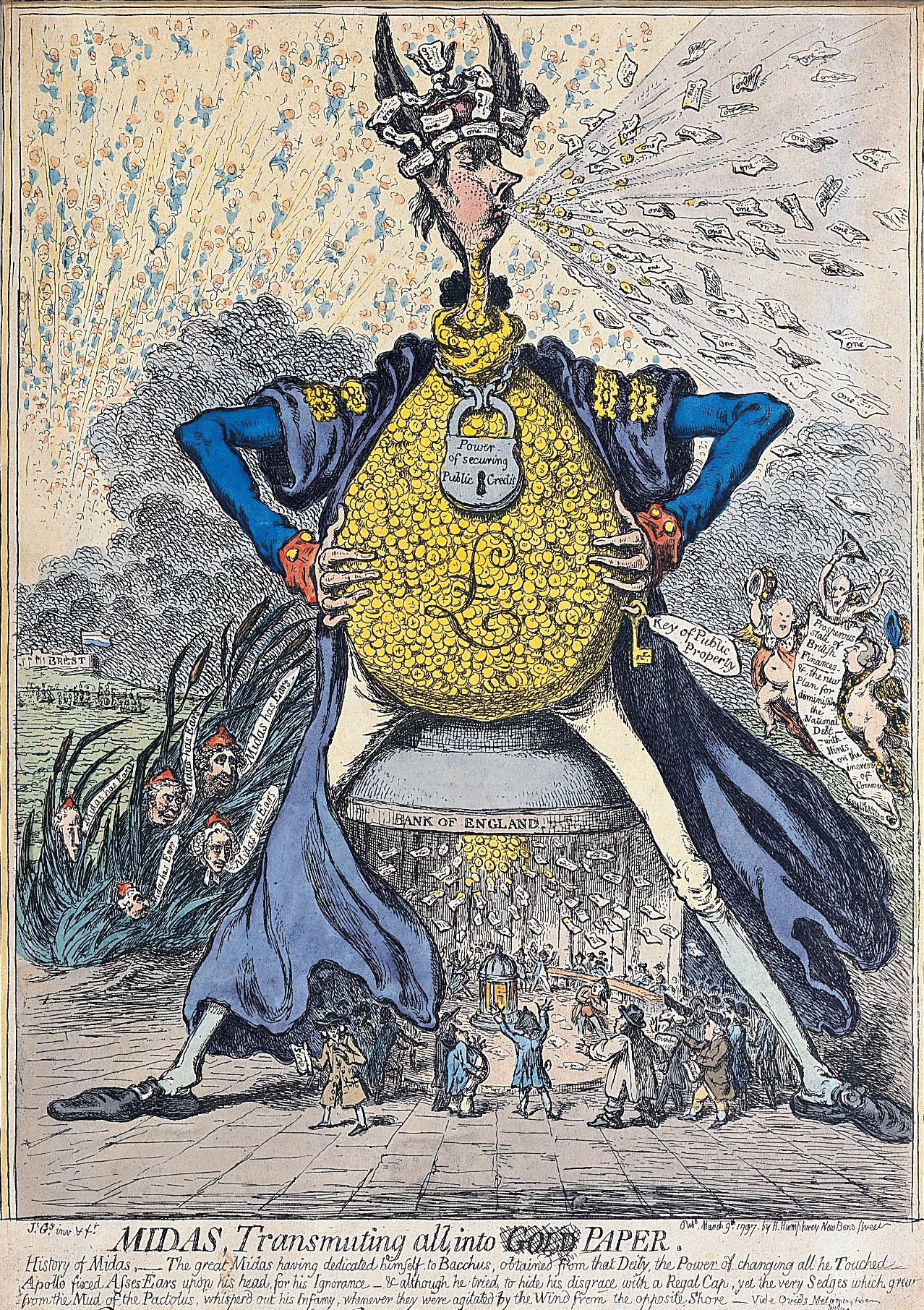
Two hundred years ago, in 1817, the Bank of England was anything but one step ahead of the forgers. The number of forged notes and coins in circulation reached record highs amid similar debates about the nature and purpose of money. The Bank’s determination to punish those convicted of forgery led to public outcry after a series of high profile trials at the Old Bailey. An unprecedented number of people were convicted of forgery and sentenced to death. Technically a form of treason, the crime of counterfeiting was a capital one. The vast majority of those convicted were poor and in many cases women. Their crime was often not the manufacture of forged notes but ‘uttering’: being in possession of or putting into circulation forged notes. ‘The mind sickens to disgust at the hideous measures taken to sustain the blood-cemented fabric of paper currency’, the radical journalist T.J. Wooler exclaimed at the height of the controversy in October 1818.
The leading critic of the government’s monetary policy at this time was William Cobbett (1763-1835), a soldier-tory turned radical journalist. For Cobbett and the thousands of impoverished working people who supported him, paper money was not money at all. In their view, only specie – predominantly gold – was proper money. Unlike paper, precious metal had intrinsic value. This was one of the pillars of the ‘gold standard’, which brought stability. The basic tenet of the gold standard was that the number of bank notes in circulation had to be backed by a fixed quantity of gold held by the Bank of England. The ‘filthy rags’, as Cobbett termed the banknotes, were merely paper promises. As the radical Thomas Paine pointed out in the 1790s, a system of pure paper money was entirely dependent on confidence, which could vanish in a moment. Not for nothing did Paine describe paper money as ‘suspicion asleep’.
Drawing on a long line of currency theory, Paine and Cobbett argued that a currency had to be based on precious metal. This did not rule out the use of paper notes, as long as they could be exchanged for specie. It was this guarantee which gave the currency, and by extension the financial system, stability. The guarantee, which still appears on banknotes to this very day, of the promise to pay the bearer on demand the requisite sum in hard cash, was a lie after 1797. Few of us stop these days to think about what this statement actually means. Today, it is little more than a symbolic survival; but during the 18th century it had meant that paper notes could be taken to a bank and exchanged for the equivalent value in specie. They were, in other words, like cheques. This changed during the Napoleonic Wars when Pitt’s government, to stop a run on the pound when fears of a French invasion were growing, suspended convertibility in 1797.
This suspension of cash payments lasted until 1821. Poor John Bull was forced to subsist on a diet of paper money and reissued Spanish dollars seized from Spanish vessels after Spain joined with France against the British and their allies. The government was accused of hoarding gold. What went in to the coffers was real money; what came out was worthless paper.
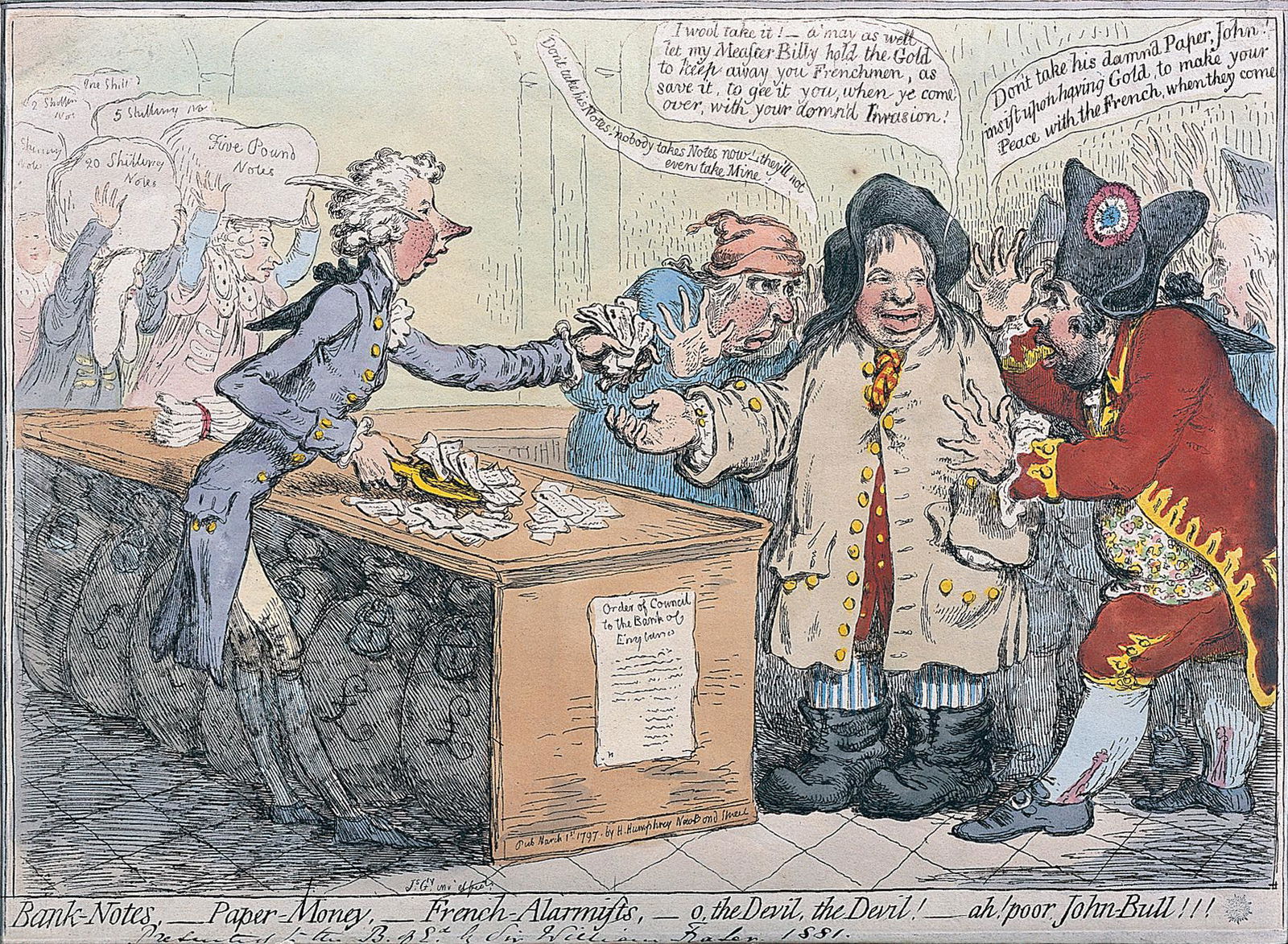
It did not take long for critics, led by Paine and later Cobbett, to read into these apparent ‘safeguards’ sinister designs by bankers and city politicians. Free of the obligation to redeem in gold debts contracted in paper, the Bank of England could in theory print as much paper money as it liked. This enabled the government to run up huge debts to finance the war against the French. While printing more money might sound like a good thing, its effect was inflation, increasing the cost of living during a period of scarcity, poor harvests and rising unemployment. As a popular journalist, Cobbett was one of the first to link the poverty of the people to the ‘money-mongering’ juggle. Week after week in his Political Register, Cobbett attacked the system of paper money and public finance. The articles were collected and published as a book in 1815, Paper against Gold. By July 1817, he claimed to have sold 150,000 copies.
The people were poor, Cobbett reasoned, because they had to pay crippling levels of indirect taxation on everyday items to pay down the exorbitant interest on the debt. Worse still, the many wars waged by the British in the 18th century had created a class of idle creditors who were able to enrich themselves by charging high levels of interest which the government was forced to to agree to finance its costly wars.
But the real scandal in Cobbett’s view was that these debts, contracted in paper money and thus hugely inflated in value, would have to be settled at some point in specie. In other words, theoretical debt would have to be paid off in real money, thus further inflating the value of the debt. It was deeply unfair, so the reasoning went, that a debt contracted in paper at, say the value of £10,000, would now be worth £100,000 because of the higher value of gold. Whose pockets would this hit? The taxpayer.
Why was the government determined to resume cash payments given the potential damage it was likely to inflict? Virtually all the experts agreed that convertibility would have to be restored to bring back sound finance and stability. This was the view taken by Lord Liverpool’s government in the 1810s, with the future Tory PM Sir Robert Peel taking charge of the legislation to resume cash payments. But how was this to be achieved without plunging the nation into financial meltdown? The amount of money in circulation would have to be reduced to bring it in line with the amount of gold held in reserve by the Bank of England. In Cobbett’s view what made this all the more unfair was that the necessary ‘belt tightening’ would fall disproportionately on the poor. Those on fixed incomes, dividends and interest payments – i.e. the creditors who had lent the money – would see no drop in the value of their investment. But ordinary people would see a fall in their wages and rising prices.
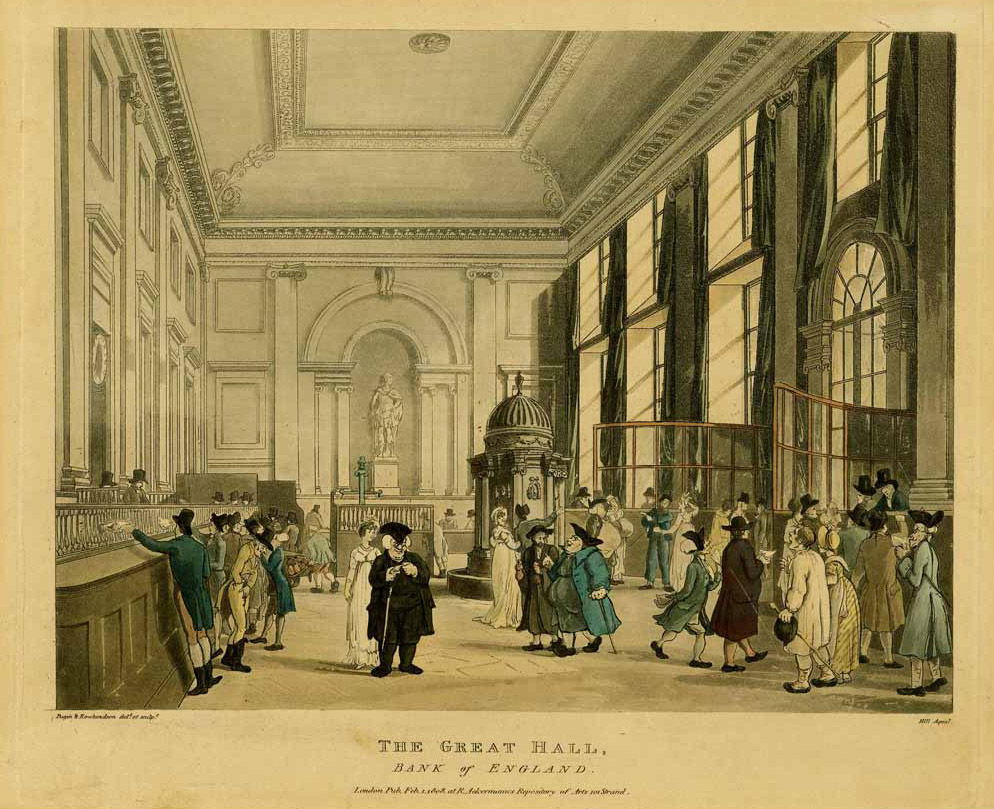
For Cobbett there was only one solution: the partial repudiation of the debt through a scaling down of its value to bring it in line with the deflated economy. This demand was regularly echoed by radicals up and down the country. Cobbett taunted the government of Lord Liverpool saying that it simply would not be able to restore convertibility without scaling down the debt. So confident was Cobbett of this that if the government achieved this he would consent to be ‘broiled alive’ on a gridiron. The gridiron became a ready-made symbol that he and his many followers adopted.
*
As it happens, the government did manage the feat but only, Cobbett was quick to allege, by cheating. The government empowered the Bank of England to print large quantities of small value paper notes. This was to ward off financial collapse due to money becoming scarcer as its value increased. Cobbett was proven wrong in that cash payments were eventually resumed (in May 1821), but he was correct that there was nowhere near enough gold in reserve for the Bank to redeem all of its notes in specie, just as there is not today. Cobbett refused to believe that confidence was sufficient to keep a nation’s finances afloat.
To make matters worse, this belt-tightening occurred during a period when the nation’s coinage was in serious disarray and short supply. Debasing, counterfeiting, the semi-legal use of tokens and even the use of foreign coins were all widely practised in the 1810s as a strategy of simply making do. This was the context for the dramatic rise in forgery. While forgery was not exclusive to London – Birmingham seems to have been another centre – the problem was much worse in the capital than elsewhere. This was partly due to London’s size, the sheer amount of money circulating there and the ready supply of materials and skills. But it was also because it was much easier and more profitable to forge notes in London than in the provinces. In the latter, country banks, which were independent of the Bank of England, issued their own notes and circulation was largely limited to a local and regional orbit. In this close-knit environment it was more difficult to utter forged bank notes as people were more suspicious of strangers bearing bank notes.
In London forgers faced fewer obstacles. The Bank of England seemed powerless, even though each year saw more convictions for forgery. By 1817 more than one in twenty £2 or £1 Bank of England notes were forged – and these were just the ones the Bank knew about. In 1817 the total number of forged £2 and £1 notes returned to the Bank of England was 28,648; in 2016 a mere 2,000 counterfeit £5 notes were removed from circulation. While the total number of forged notes is much higher today than it was 200 years ago, with the vast majority being counterfeit £20 notes, as a proportion of the total number of bank notes in circulation the percentage is much lower.
Sermons were preached on the sinfulness of forgery, complete with gruesome details on the psychological terror inflicted on those found guilty when sentences of death were passed. But nothing, not even the threat of death, was enough to deter the counterfeiter. The situation had become so dire by December 1817 that the Bank of England revived its defunct committee to examine plans for improvement of bank notes and prevention of forgery. Suggestions included the use of invisible ink, incredibly ornate designs drawn by artists, unique and superior kinds of paper and watermarks and the need for the most up-to-date printing technology to out-skill the forgers. The committee reported that
Great expectations are entertained by some that the science of chemistry in which such wonderful discoveries have been made of late years may be the means of improvement either in the materials of the paper or in the composition of the ink, or by supplying tests whereby to distinguish the genuine from the false note.
Eventually, the Bank adopted a combination of such features, as it continues to. As the committee conceded, the best the Bank could hope for was to stay one step ahead of the forgers:
This much is certain that the counterfeiters of the coin of the realm and the forgers of bank notes, both united … frequently in the same persons, are men of great ingenuity and of versatile talents and it is not too much to presume that their exertions will keep pace with any measures which may be adopted.
In the meantime, the Bank built up an impressive network of detectives and informers to mount one of the most organised private prosecution agencies in modern British history. Masterminded by its solicitors, Freshfields, the directors of the Bank liberally employed vast sums in prosecuting forgers. No expense was spared. Rewards were provided for information leading to convictions. Preserved in the archives of the Bank of England are confessions, plea bargains and all manner of information regarding forgery. One of the fullest accounts was furnished in 1820 by Edward Ewer, an inmate of Reading gaol. It seems that markets and fairs were at the operational centre of counterfeiting:
There is scarcely a stall keeper, fishman or horsedealer frequenting all the fairs but what deals in forged notes and base coin. They cannot live without it. They sell their articles lower than they purchase them and keep the stalls only as a blind.
*
Building on the platform he had constructed in Paper against Gold, Cobbett seized on the forgery cases as further evidence of the iniquities of the paper money system. Since paper money was fiction, Cobbett reasoned that there was, in fact, no difference between bank notes and forged notes; one was legal forgery, the other illegal. Capitalism and counterfeiting were different sides of the same coin: the transition to a paper-based currency and the attendant proliferation of notes, often of poor quality, created ideal conditions for counterfeiting. After all, the currency of both rested on confidence and, while forged notes might be bad money, legal notes might be issued by a bad bank (i.e. one unable to meet its obligations). The British government had even entered into the business of counterfeiting in the 1790s when it had the currency of the French revolutionaries, the assignats, forged in London and circulated in France to try and undermine the new regime.
With Cobbett in exile in the United States, having fled to avoid imprisonment for spreading sedition, it fell to T.J. Wooler to lead the public outcry. Through the pages of the Black Dwarf Wooler stoked anger against the forgery convictions, marshalling it into a determined campaign to abolish capital punishment for all crimes except murder. The necessity of such reform became very apparent during the forgery trials between September and December 1818. The trials revealed that it was difficult to distinguish between a forged and a genuine bank note, largely because of the poor quality of the latter. The arbitrary manner in which bank officials determined which notes were forged, and their refusal to divulge the criteria against which they made such determinations, outraged Wooler and the public.
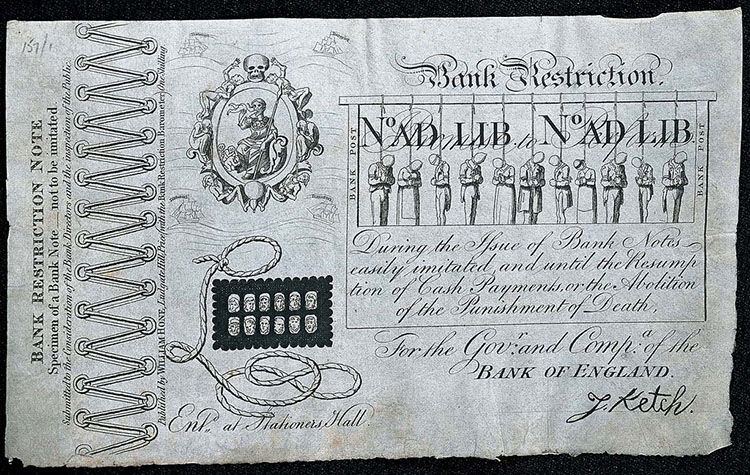
Just under a third of those hanged in London in the period 1800-18 were forgers/utterers, some of them poor women driven to the crime as a means of survival. Some of the letters written to the Bank from those convicted for forgery requesting assistance attribute their deviation from the path of rectitude to the prevailing distress in the postwar years. This made the Bank’s prosecutions look like petty acts of class war. The Bank’s ruthlessness in pursuing forgers represented in microcosm the wider fears of the commercial classes. Where Cobbett and Wooler led in print, George Cruikshank and William Hone followed in visual satire by producing the most iconic rendition of the forgery crisis with his spoof counterfeit Bank Restriction Note and Barometer (1819).
The crime of counterfeiting was eventually declassified as a capital offence in 1836. Thereafter conviction rates for forgery shot up. Now that the crime was no longer a capital offence juries were more likely to return guilty verdicts. Certainly, judging by the number of trials at the Old Bailey, there had been no decline in ‘coining’ offences. The high number of offences in 1817-21 (with a peak of 78 offences in 1818), following a lull in the 1820s, were easily surpassed in the mid-1830s. There were 90 offences in 1835 alone. Yet conviction rates were on average much higher in the 1830s and 1840s than they had been in the 1810s and 20s: in 1818, 78 per cent of those on trial had been found guilty; by 1836 the figure was 99 per cent. The Bank of England had begun to turn the tables in its favour.
Two hundred years ago the Bank of England was forced to confront some of the same questions it faces today: What is money? What should it be made of? What does it represent? And what should be done regarding the attendant problems of counterfeiting? One consequence of the forgery trials was the introduction of banknotes that were more difficult to counterfeit. The new £5 and £10 notes are merely the latest in a long line of anti-counterfeiting measures. Neither are a crippling National Debt or accusations of unholy alliances between city bankers and politicians new. Cobbett would have found today’s City much as he left it in 1835.
Matthew Roberts is Senior Lecturer in Modern British History at Sheffield Hallam University.



